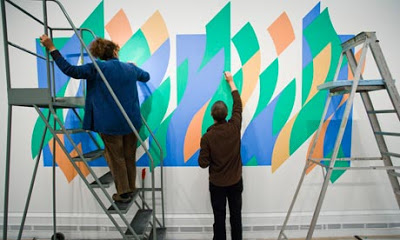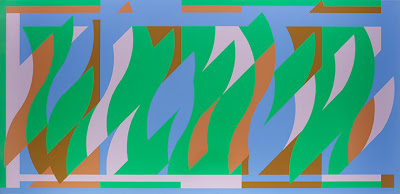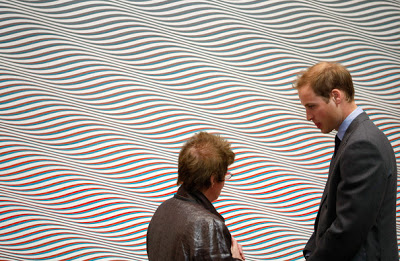‘The curious effect of this tremendous show, in which Riley’s paintings are displayed alongside permanent works she has selected from the collection, is that it makes you see past art anew.” Cummings writes. “Look at her suave ripples and you suddenly realize how Mantegna makes his frieze of figures appear to move continuously in both directions. Look at Riley and you may better appreciate the abstract qualities of Raphael.
“These old-new pairings soon give way to what is effectively a miniature retrospective � early op-art, 80s stripes, the recent parallel curves and steeply flaring diagonals, cross-cut by verticals. The main gallery is all Riley, and dominated by an immense mural composed of interlinking circles, approximately one metre across, in blazing black on white. Tightly plotted, yet open-ended, it sends the eye round and around in every direction, following the tracery, drawn by particular rhythms, distracted by sparking intersections; a movement as unpredictable as mercury. The means are simple and perspicuous, but the effect is indefinable….
“You can count the stripes, you may even be able to guess what constitutes a warp and a weft in her most dizzyingly complicated compositions, but once the eye is in there it loses hold of what is going on. Take “Arcadia 1,” not just the masterpiece of this show but one of Riley’s greatest works. Green and white and corn and a beautiful variation of cobalt, it is painted directly on the wall. The blue appears to act as a steadying backdrop, but then it leaps forward, taking part in the intersection of curves, verticals and diagonals that create a whole pageant of shapes: leaves, kites, twisting ribbons, the dipping hooves of merry-go-round horses. There is no stopping place, every element is designed, and combined, to send the eye flowing onwards.
“What you find in this painting may involve music, ballet or ships in full sail. It might have something to do with the seasons, landscape, sunlight or water, as pastoral as the title suggests � common subjects of the National Gallery. But this picture is not figurative. It depicts none of these things. So how does it conjure them all? What Riley offers is an infinite variety of optical experiences, of vitality, freedom, elation. Ultimately the painting appears to float free of the wall itself, nothing pinned down: as open to the eye as the imagination.”
“Bridget Riley: Paintings and Related Work,” National Gallery, London. through May 22, 2011




















We cannot wait to see this show! thanks to your review even less! 🙂
Google Doodles today depicts Bob Ross �Joy of Painting� for more information
http://www.trendsfair.com/google-dooles-today-depicts-bob-ross-joy-of-painting/
Bob Ross, The Google home-page awards public television tale �Bob Ross�, who would have famous his 70th wedding today, The �Google Search engines� home-page these days shows a big-haired artist with a rabbit on his…